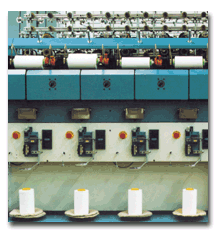Italian Textile IndustryBy Piergiuseppe Bullio, European Correspondent Model Mill: Italy’s
Torcitura B and B
Italian yarn producer combines years of art and tradition with modern technologies to stay
competitive.

Torcitura B and B, a silk manufacturer in Italys Crema province, has demonstrated its lively
legacy of experience, knowledge and business skills for more than 25 years, blending innovation and
tradition in typically Italian style.For years, by scrupulously pursuing production quality in raw
silk and man-made yarn processing, as well as continuously updating technologies, B and B has
asserted its competitive presence on the market in Italy and the world.B and B traces its origins
to SATEX, a raw silk thrower founded in the late 19th century. At that time, the cultivation of
silkworms in Italy, which had flourished from the turn of the century until after World War II, was
in decline because of insufficient production to meet market demand. Raw material was imported from
China because of its high quality and later from Brazil. B and B was established in 1976 and, in
the 1990s, added to its silk-throwing activities by throwing yarns such as acetate, viscose, nylon
and polyester. Today, the B and B plant covers 10,500 square meters. Production of yarn totals
300,000 kilos per year, of which 70 percent is silk and 30 percent is man-made.Originally from
China, silk culture was introduced to Mediterranean countries around 500 A.D. In the centuries to
follow, silkworm culture spread throughout Europe. Italy, the worlds top producer of yarn and
fabrics until the 18th century, is still famous for the high quality of its silk products.Imported
raw silk, especially from China, comes for processing in the form of a hank. Through the various
treatment processes, different types of yarns are produced that can be used for anything from
scarves to shirts, and from ties to bridal gowns. The first treatment phase consists of a bath in
natural substances part of each companys secret recipe which makes the yarn softer and more
pliable. Then, the hank goes to the winder, where the yarn is wound on a spool and then loaded into
the uptwisting machine. This is followed by steaming, doubling and, finally, spooling, where the
yarn goes from the twisted bicone to the final package.A 1-kilogram bobbin raw yarn of 20 to 22
deniers produces a yarn approximately 428 kilometers long, the distance from Turin to Venice. At
this point, using new-technology machines, any imperfections in the yarn are removed through
slub-catching, measuring, antistatic oiling and precision traversing, which facilitate and prepare
the yarn for dyeing or weaving processes.After this meticulous crafting with an entire production
process lasting from one to two months the scientifically processed yarn is entrusted to human
skill and experience for quality control. Under expert eyes, even the tiniest defect can be
spotted. Of course, man-made fibers undergo the same production treatment before being presented
for dyeing and weaving. These fibers can be mixed with each other or with silk, depending upon
market demand and fashion, which uses the yarn for knitwear and apparel fabrics. Today, the trend
is to use silk crepe combined with viscose or cotton mixed with polyester in various combinations
obtained by high-technology machines.Traditional craftsmanship is still a part of the initial
phase, production control and final inspection. The 1980s were an important turning point for
Torcitura B and Bs productive innovation and the potential created by the introduction of new
technologies. As the textile sector adopted new high-speed looms and new coloring techniques,
production parameters for winding also needed to be changed, making yarn processing overall more
modern, efficient and rapid. Throughout the companys existence, there has always been constant
cutting-edge attention to updating machinery, which needs to follow the rhythms of the textile
sectors entire cycle. The process is accompanied by the increasingly attentive pursuit of quality
in the workplace and the environment in general. Wastewater from the yarn-bathing process has been
eliminated to avoid pollution. Clean technologies have been adopted for purification, and natural
substances are now used to better protect the environment and its natural equilibrium.By using the
most advanced technologies in processing silk and man-made yarns, Torcitura B and B has become one
of the leading textile mills in Italy, with a reputation for high quality and a large array of
products released on the market every year. In Italy, this market, handled by a network of sales
agents, consists of large fabric weavers and converters around Como, Biella, Prato and Carpi areas
known worldwide for their ancient textile history. Outside of Italy, B and B sells its yarns
primarily in Switzerland and Germany, which, in turn, supply the U.S. market. Of course, fashion
trends influence production decisions, which today are experiencing an increase in demand for pure
silk as well as fibers combined with silk; such as silk and viscose, silk and wool, silk and nylon,
and silk and acetate.The company is now committed to more strongly asserting its presence within
Italy and Europe by strengthening a more widespread network of sales agents. In addition, the
company maintains a strategy that constantly pursues product quality, environmental quality and
increasingly advanced technological updating. It believes this is the only way to meet the
competition from other countries. By implementing strategies designed for the immediate future, B
and B counts on increased sales of its textile products and higher revenues.In order to stem the
flow of imitation Made in Italy products that have appeared in recent years, B and B, in
collaboration with the Associazione torcitori italiani della seta, has established a quality mark
for Italian twisted silk. The various products from the entire silk-processing cycle, from
spinneret to finished fabric, may be released on the market with the associations certification and
mark. This mark will also indicate the social commitment of the producers, which operate in full
compliance with silk production processes, from working conditions to environmental protection.
February 2002




